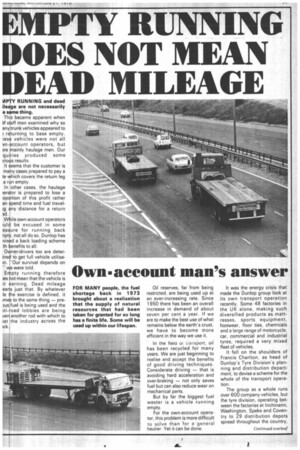MPTY RUNNING OES NOT MEAN EAD MILEAGE
Page 55

Page 56

If you've noticed an error in this article please click here to report it so we can fix it.
1/1PlY RUNNING and dead ileage are not necessarily e same thing.
This became apparent when (4 staff men examined why so any trunk vehicles appeared to ? returning to base empty. lese vehicles were not all vn-account operators, but are ainly haulage men. Our quiries produced some ino s results.
It eems that the customer is ma y cases prepared to pay a te hich covers the return leg a r n empty.
In other cases, the haulage iera or is prepared to lose a op rtion of this profit rather an pend time and fuel travel ny distance for a return ad.
W ile own-account operators rut be excused in some ea ure for running back Nat , not all do so. Dunlop has d a back loading scheme th Ilenefits to all.
O ner-drivers too are deterine to get full vehicle utilisain. 'Our survival depends on e were told.
E pty running therefore ,es hot mean that the vehicle is )t earning. Dead mileage ears just that. By whatever le the exercise is defined, it
■ rnes to the same thing — prexis fuel is being used and the ti-oad lobbies are being yen another rod with which to at the industry across the FOR MANY people, the fuel shortage back in 1973 brought about a realisation that the supply of natural resources that had been taken for granted for so long has a finite life. Some will be used up within our lifespan. Oil reserves, far from being restricted, are being used up at an ever-increasing rate. Since 1950 there has been an overall increase in demand of about seven per cent a year. If we are to make the best use of what remains below the earth's crust, we have to become more efficient in the way we use it.
In the field ot transport, oil has been recycled for many years. We are just beginning to realise and accept the benefits of good driving techniques. Considerate driving — that is avoiding hard acceleration and over-braking — not only saves fuel but can also reduce wear on mechanical parts.
But by far the biggest fuel waster is a vehicle running empty.
For the own-account operator, this problem is more difficult• to solve than for a general haulier. Yet it can be done.
It was the energy crisis that made the Dunlop group look at its own transport operation recently. Some 48 factories in the UK alone, making such diversified products as mattresses, sports equipment, footwear, floor ties, chemicals and a large range of motorcycle, car, commercial and industrial tyres, required a Very mixed fleet of vehicles.
It fell on the shoulders of Francis Charlton, as head of Dunlop's Tyre Division's planning and distribution department, to devise a scheme for the whole of the transport operation.
The group as a whole runs over 600 company vehicles, but the tyre division, operating between the factories at lnchinann, Washington, Speke and Coventry to 29 distribution depots spread throughout the country, operates only 20 tractive units and 50 boxvan trailers over long hauls.
This relatively small fleet is backed up by the fleets of 25 general haulage companies, some of which work almost exclusively for Dunlop.
It was clear that if a back loading system could be devised, to within a 30-mile radius of home base, not only would the Dunlop fleet be more profitable, but the general hauliers too would derive some of the benefit from more productive vehicles. With co-operation from all of the group's transport managers, each keen to show savings for their own areas, a scheme was evolved.
On the face of it, the solution was a simple one but needed some organisation. Each day, before four o'clock in the afternoon, all details of the following day's traffic was to be supplied by telex to a central control office at Fort Dunlop.
This information could then be passed on to the appropriate one of 14 designated areas so that the traffic manager responsible would know the number and type of vehicles requiring return loads on that day.
Of course it did not just work like that and there were problems, both human and commercial, that had to be overcome, but through perseverance and persuasion in some areas, up to 95 per cent of return journeys have been accommodated.
A combined saving to Dunlop of own-account 'and general haulage costs amounted to £100,000 in the first year. In the intervening years to 1977, this sum has risen to a total in excess of £11/4 m, which must be considered worth while in any operation.
Looking towards the future, there is room for development of the already successful roll on/ roll off traffic to and from Ireland. Greater rationalisation of production at the individual plants may offer better opportunities to extend the scheme to include other factories based abroad in Germany and France. However, that idea and a few more for further improvements, are still in the melting pot.




































































































